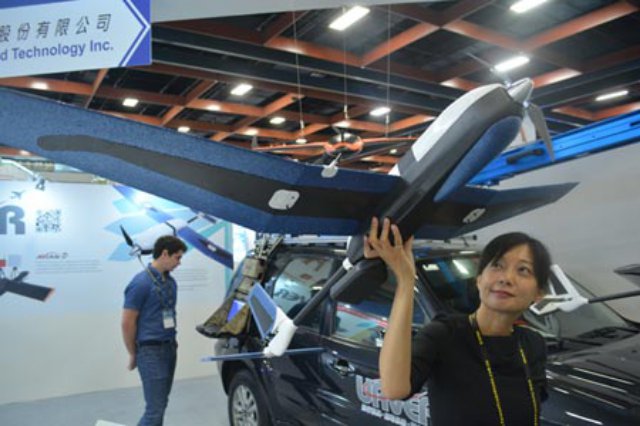
Cindy Chu, a representative of UAVER, demonstrates the Besra hand-launched drone to visitors at the Taipei Aerospace and Defense Exhibition
By establishing a partnership with Carbon-Based Technology, also known as UAVER, a leading manufacturer of unmanned aerial vehicles based in Taichung, the US-based Navmar Applied Sciences Corporation (NASC) hopes to expand its reach into the global drone market.
As a defence contractor in the United States, the NASC hopes to explore the potential market for unmanned aerial vehicles designed for commercial use, according to Probyn Thompson, the company’s regional area coordinator. Thompson said drones currently mainly produced for the military today are subject to restrictions imposed by the Federal Aviation Administration.
Drones can be designed for law enforcement, agriculture, aerial mapping and large development projects, Thompson said, adding that in the future, even companies like Amazon and UPS can carry out their delivery service with unmanned aircraft systems.
The NASC needs partners around the globe to accomplish its goals, and used the opening ceremony of the 13th Taipei Aerospace and Defense Technology Exhibition as a platform. At the event, NASC announced its partnership with UAVER. With the assistance of NASC, UAVER will be able to introduce two of its primary UAV products known as Swallow and Avian to the US and Canadian markets.
In addition to these two drones, developed for aerial mapping and surveillance operations, the UAVER’s Besra hand-thrown launch UAV is likely to be exported to North America through this channel as well. The Taiwanese firm is estimated to be able to turn a profit of US$1 million during its first year of cooperation with the NASC.
“We chose UAVER because it designs and produces smaller and cheaper unmanned aerial systems while we focus on developing larger and more expensive vehicles,” said Thompson, emphasizing that the quality of UAVER’s drones was also a factor.
Thompson added that a drone should be viewed more as a system instead of a vehicle. “If what we are looking for is a vehicle, we can simply order Phantoms from [Shenzhen-based]DJI in China,” said Thompson. “The command and control as well as the launching systems are what really matter to make a drone from a single vehicle into a full operational system.”
Stressing his full confidence in the ability of UAVER to design quality drones, Thompson said he wanted to change the public’s impression of UAVs. “I think it is more proper to call a drone a Remotely Piloted Aircraft System instead of unmanned aerial vehicle,” he said, adding that “after all, drones are not controlled by Skynet or other type of supercomputer, but humans.”
Mobilizing drones in war has created a stereotype of UAVs, Thompson said, but the system has civilian uses just like any other technology.
“The Taiwanese military is not interested in buying our products,” said Jay Chen, sales representative for UAVER. “What we have to do now is to seek cooperation from foreign consumers including China.”
Photo: Samuel Hui
Source: Want China Times
